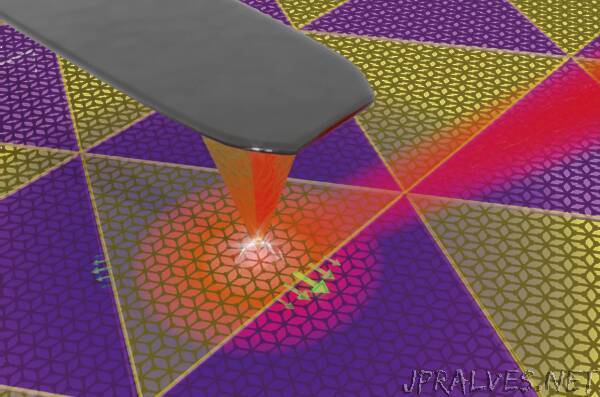
“In a significant development in the field of superconductivity, researchers at the University of Manchester in collaboration with ICFO have successfully achieved robust superconductivity in high magnetic fields using a newly created one-dimensional (1D) system. This breakthrough offers a promising pathway to achieving superconductivity in the quantum Hall regime, a longstanding challenge in condensed matter physics.
Superconductivity, the ability of certain materials to conduct electricity with zero resistance, holds profound potential for advancements of quantum technologies. It is for example used in key elements of future quantum computers. Notably, it was proposed that a robust superconductivity under strong magnetic fields could allow the creation of fault-tolerant quantum bits. However, achieving superconductivity under these conditions – in the so-called quantum Hall regime – has proven a mighty challenge.
The research, published in Nature, details an extensive work to achieve superconductivity in the quantum Hall regime led by a University of Manchester team, with the recently appointed ICFO researcher Dr. Julien Barrier as its first and corresponding author, in collaboration with ICFO researcher Dr. Roshan Krishna Kumar and ICREA Professor Frank Koppens and other international institutions (the Kyung Hee University, University of Lancaster, National Institute of Materials Science and Yale University). They report on a novel method where superconductivity is supported by one-dimensional states.
Superconductivity with one-dimensional electrons
The researchers’ initial efforts to induce superconductivity in high magnetic fields followed the conventional route in this community. In the proximity effect, a superconductor can induce its properties in a normal metal placed in contact with it. They intended to couple electrons propagating along device edges. To this end, the team started using a single graphene layer, cut in half with both sections kept only around 10 nanometers apart. Edge currents were expected to couple together at narrow distances, but the experiment proved otherwise: the distance between electrons was still too high.
The team built upon the acquired knowledge and followed with two graphene layers, one on top of another, misaligned by a very small angle (around 0.1°). In this situation, the sheets’ structure rearranges because of important strains, which results in a very different configuration where μm-scale domains form. These multiple regions are separated by narrow domain walls which were employed in the present study. Along these walls, the researchers proved that the electrons could propagate.
By exploiting this technique, “we fabricated superconducting junctions and observed a remarkably strong supercurrent at relatively ‘balmy’ temperatures (up to one Kelvin) in every single device”, explains Dr. Barrier. “This was very encouraging, but we did not know the number of domain walls or where they were located. Probably, this was the biggest challenge we had to overcome”.
Luckily, at that time, Dr. Roshan Krishna Kumar and Prof. Frank Koppens from ICFO had just released a technique to observe domain walls in encapsulated devices. “After discussing with Dr Krishna Kumar and Prof. Koppens, we sent a few devices to be imaged at ICFO, which allowed us to select the ones where we had certainty to have only one or two domain walls”, recalls Barrier.
Thanks to these selected devices, the team was able to prove that the domain walls carried single-mode supercurrents, i.e. strictly 1D electronic states. With the study of devices incorporating a single domain wall, the research team was able to prove that their original interpretation of quantum Hall edge states forming on each side of the domain wall and coupling together to induce the superconductivity could not be correct. The domain walls carry their own one-dimensional electrons, which support more robust supercurrents at high magnetic fields than traditional quantum Hall edge states. The Manchester team also demonstrated that these states could be manipulated using gate voltages, and their superconducting properties could be influenced by the number of walls in a single device.
Overall, ICFO’s imaging technique was crucial to prove that the observed superconductivity was caused by purely one-dimensional states, which allows such an effective superconductivity in the quantum Hall regime.
Opening the door to new physics discoveries
The discovery of single-mode 1D superconductivity shows exciting avenues for further research. These one-dimensional electron channels could be used in research outside of the field of superconductivity. High electron mobilities like the ones reported in this experiment are rare to achieve, because defects in the material tend to disrupt their motion. The ability to maintain high velocities is extremely desirable, since it can reduce heat dissipation of electronic devices, and most importantly, is a pre-requisite to induce new physics. For instance, high mobility in 2D systems allowed fascinating phenomena like the integer and fractional quantum Hall effects (Nobel Prizes in 1985 and 1998, respectively) to be observed.
Dr. Barrier concludes: “Our system introduces a novel platform for exploring physics in one-dimension. While we demonstrated its application in superconductivity, this 1D system holds promise for a vast range of technological advancements and fundamental research. The potential for our 1D system remains open-ended”.
Bibliographic reference
Barrier et al., “One-dimensional proximity superconductivity in the quantum Hall regime” Nature number 628 issue 8009, (2024)”
